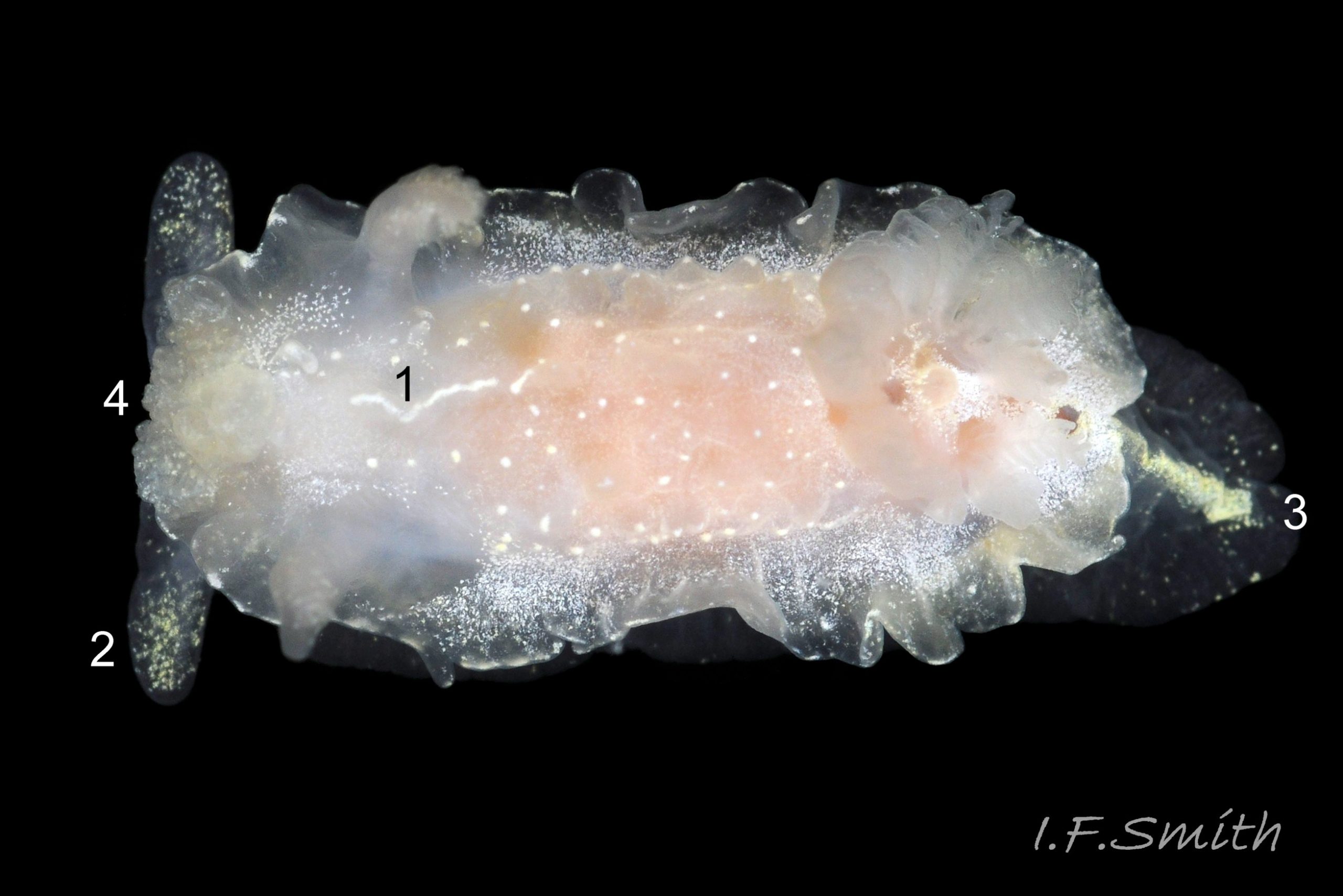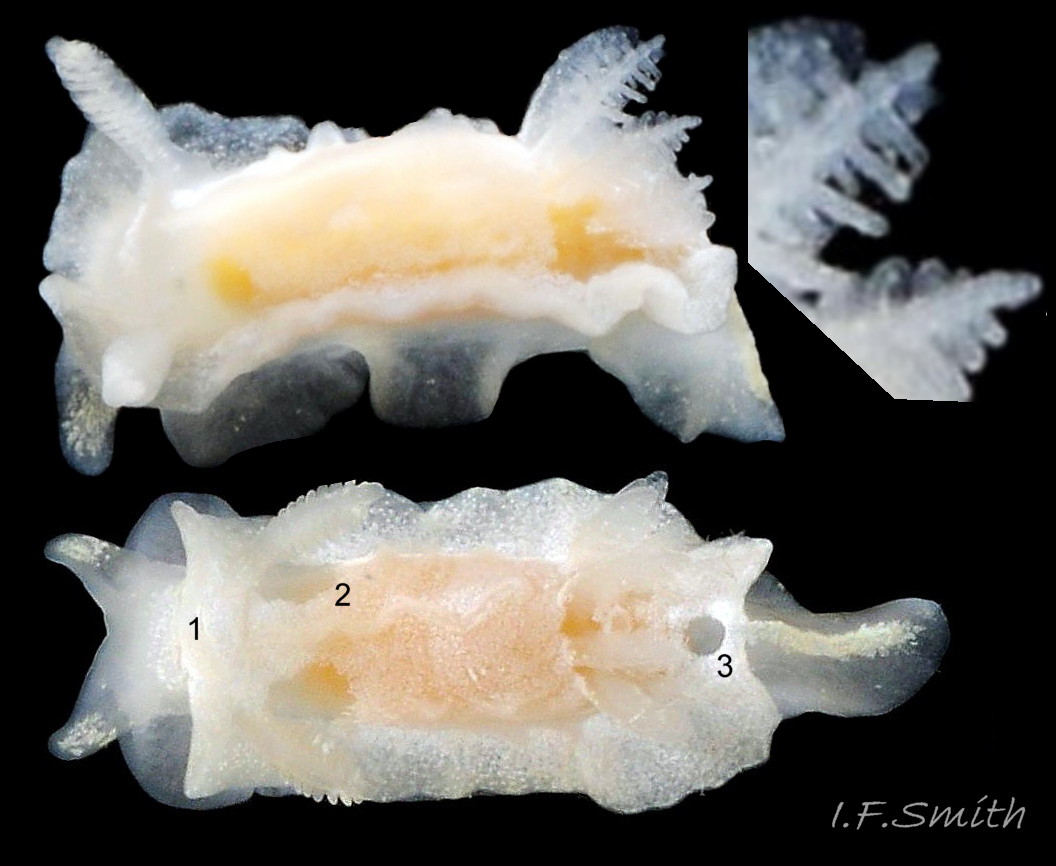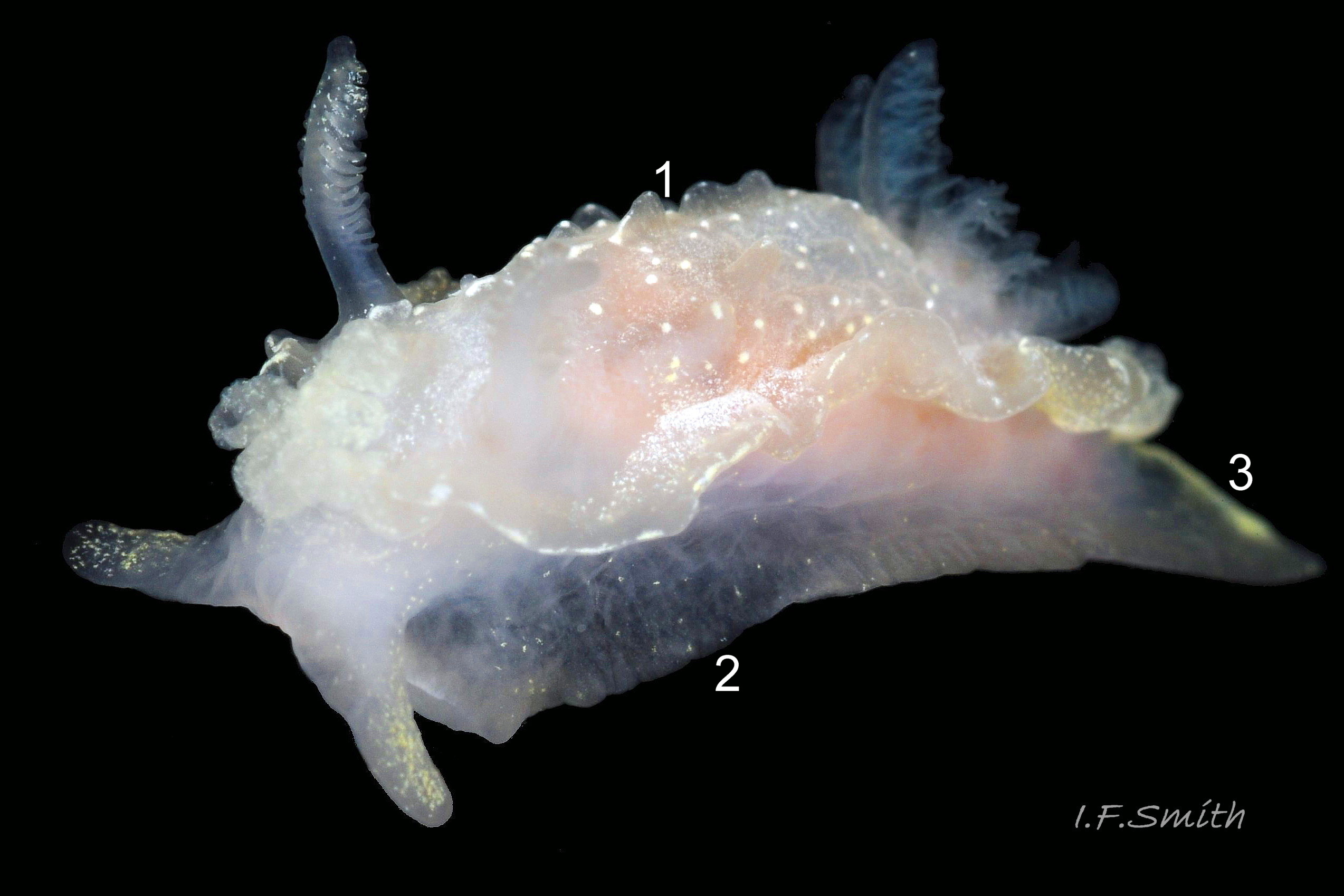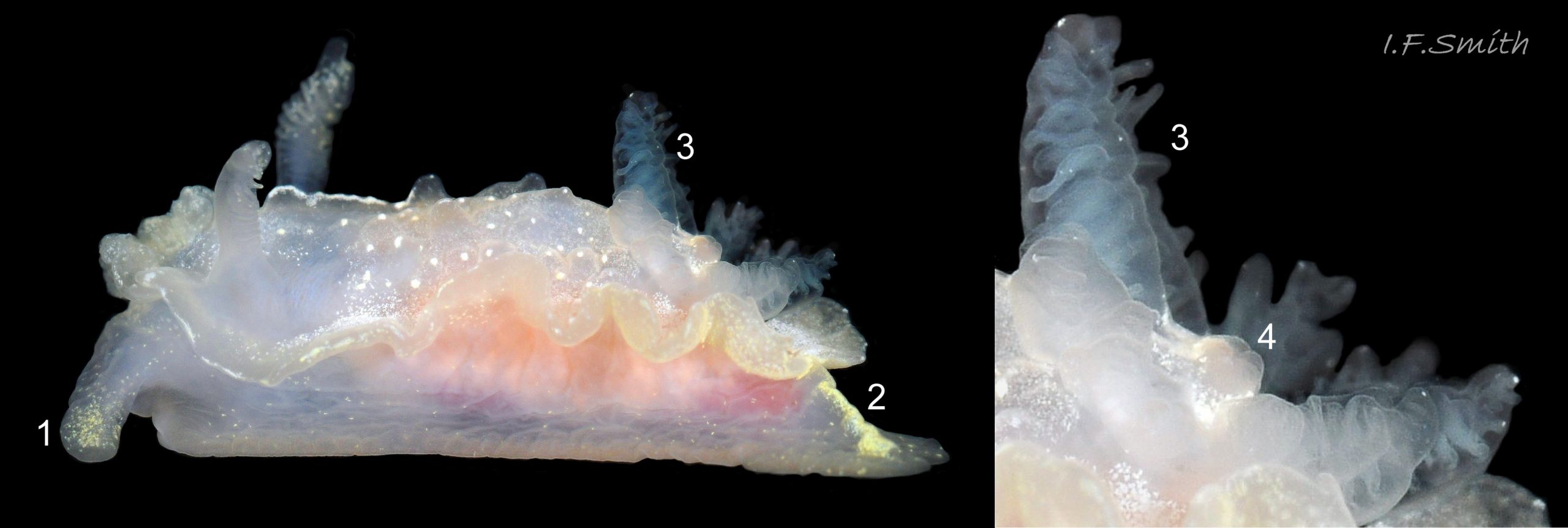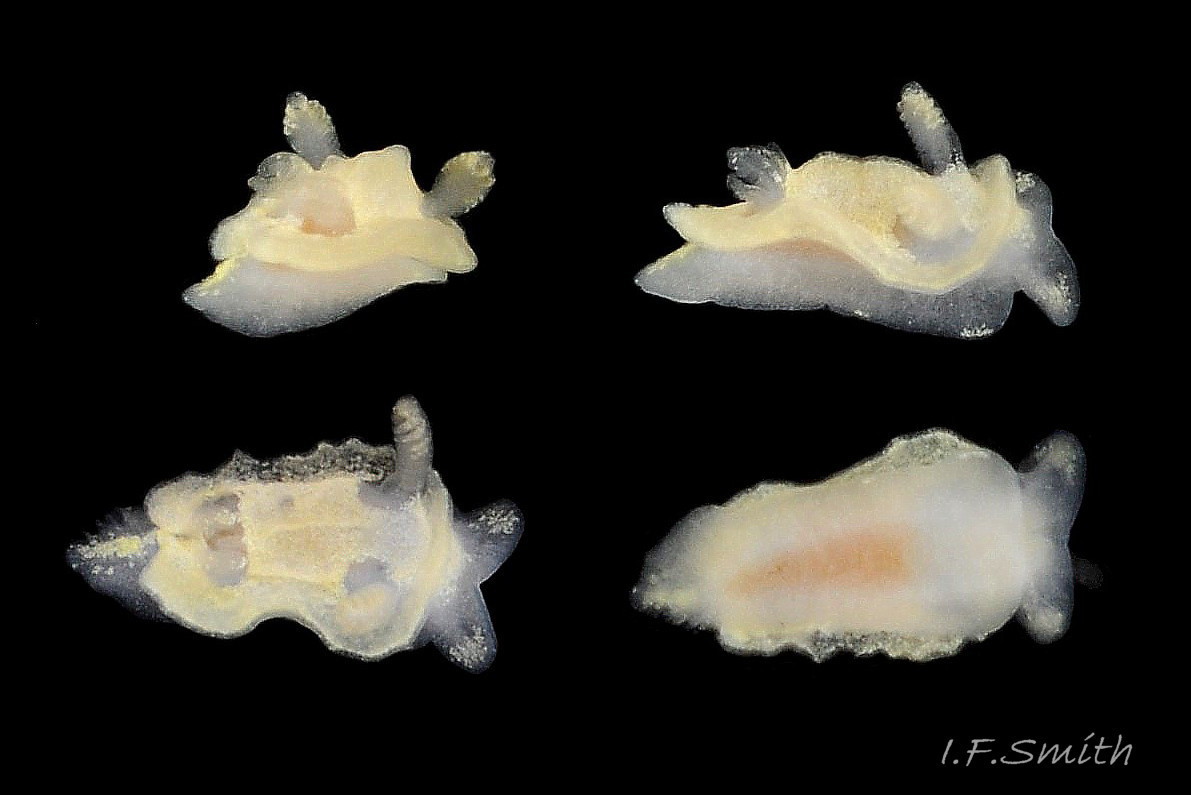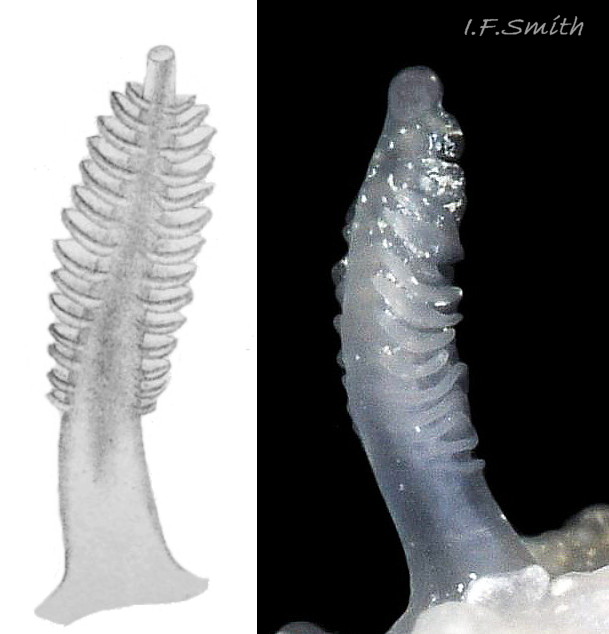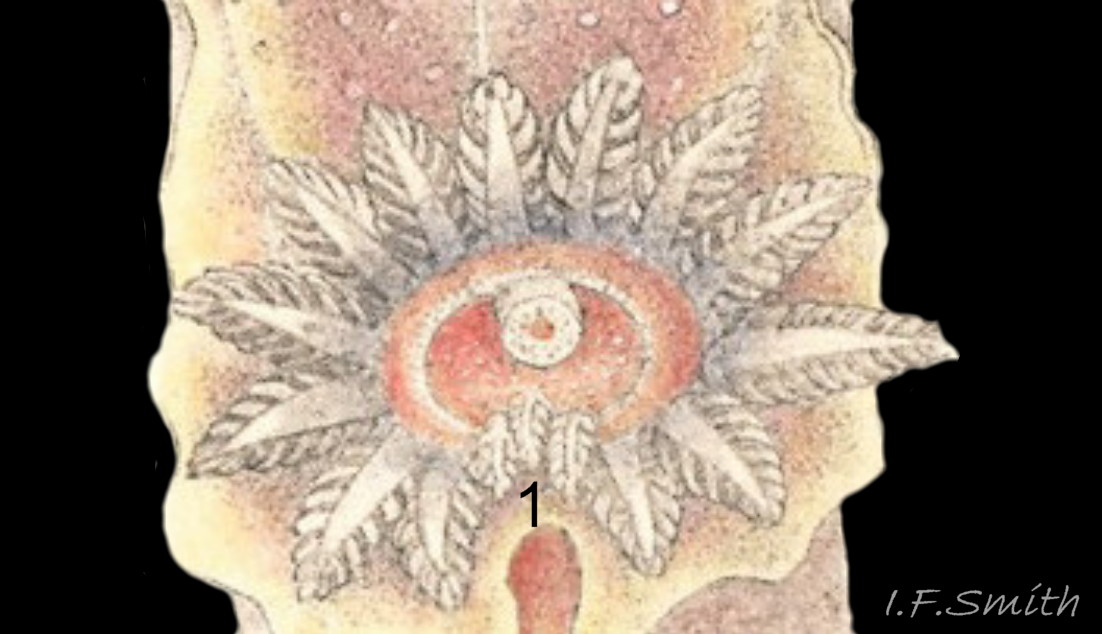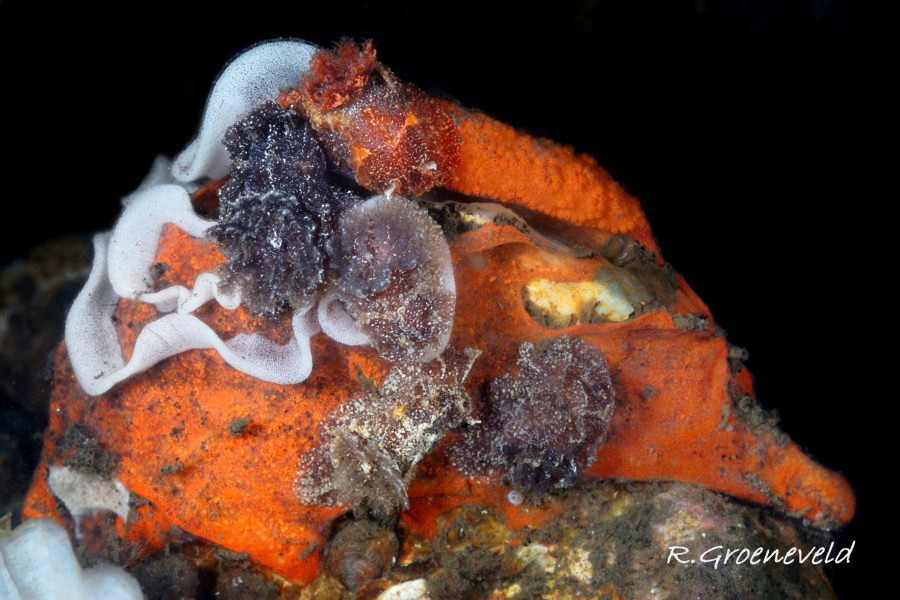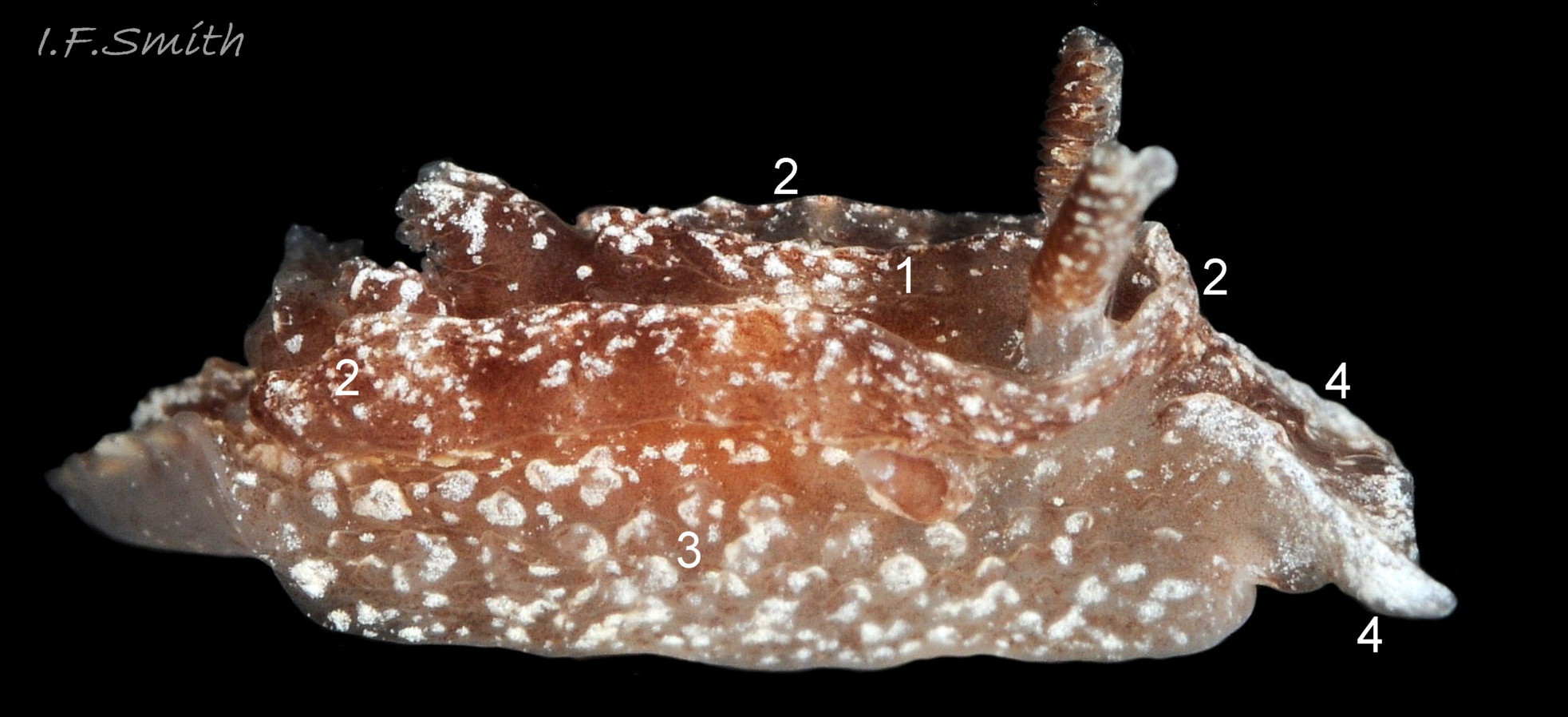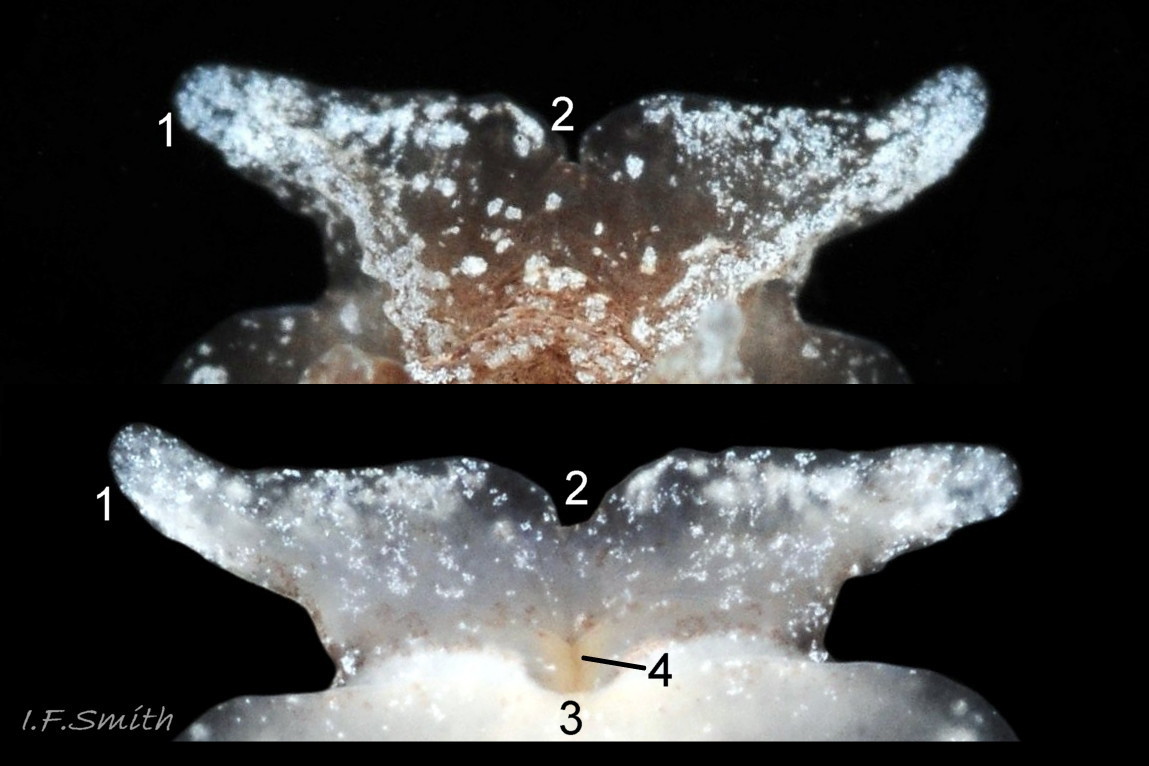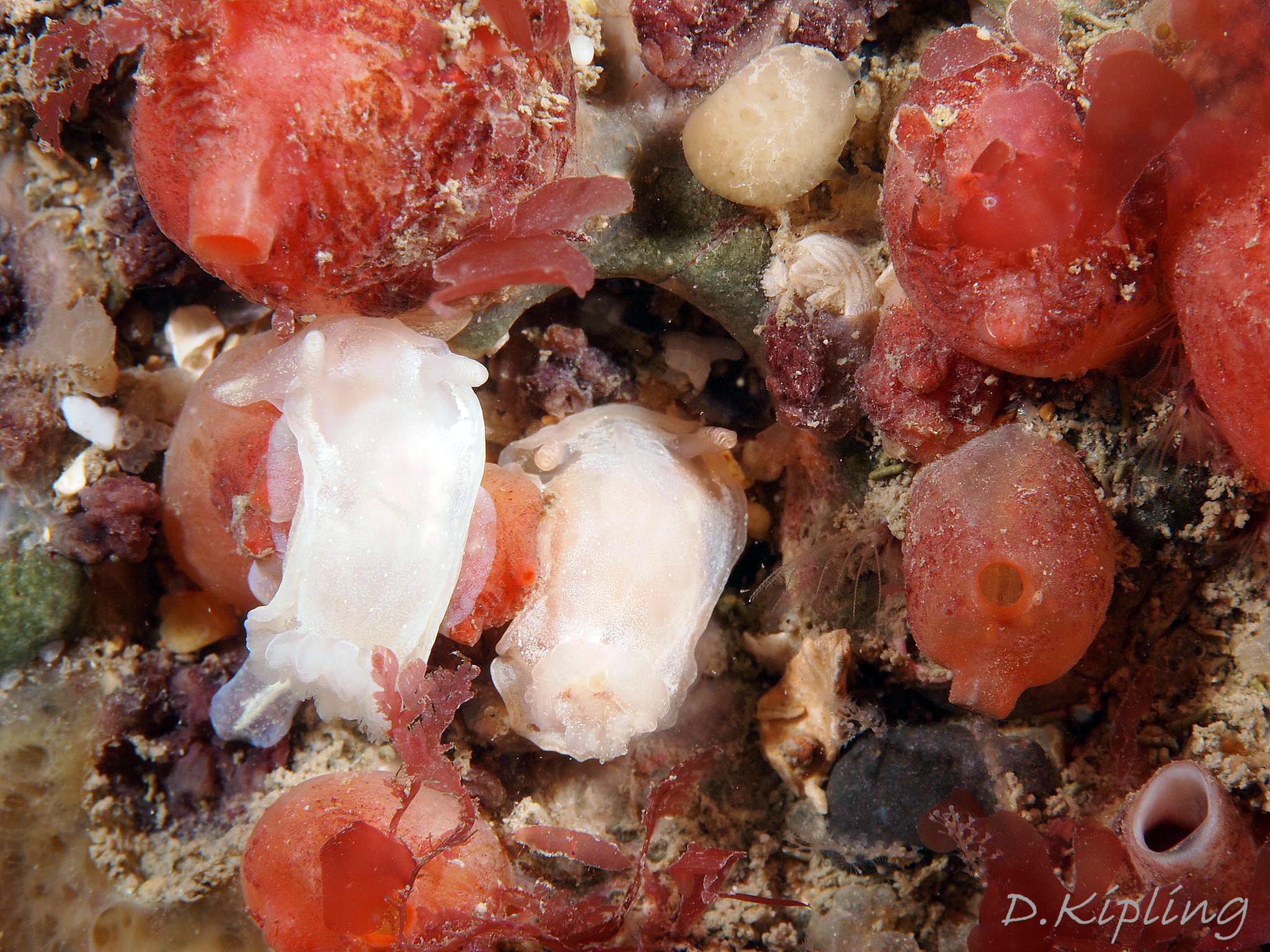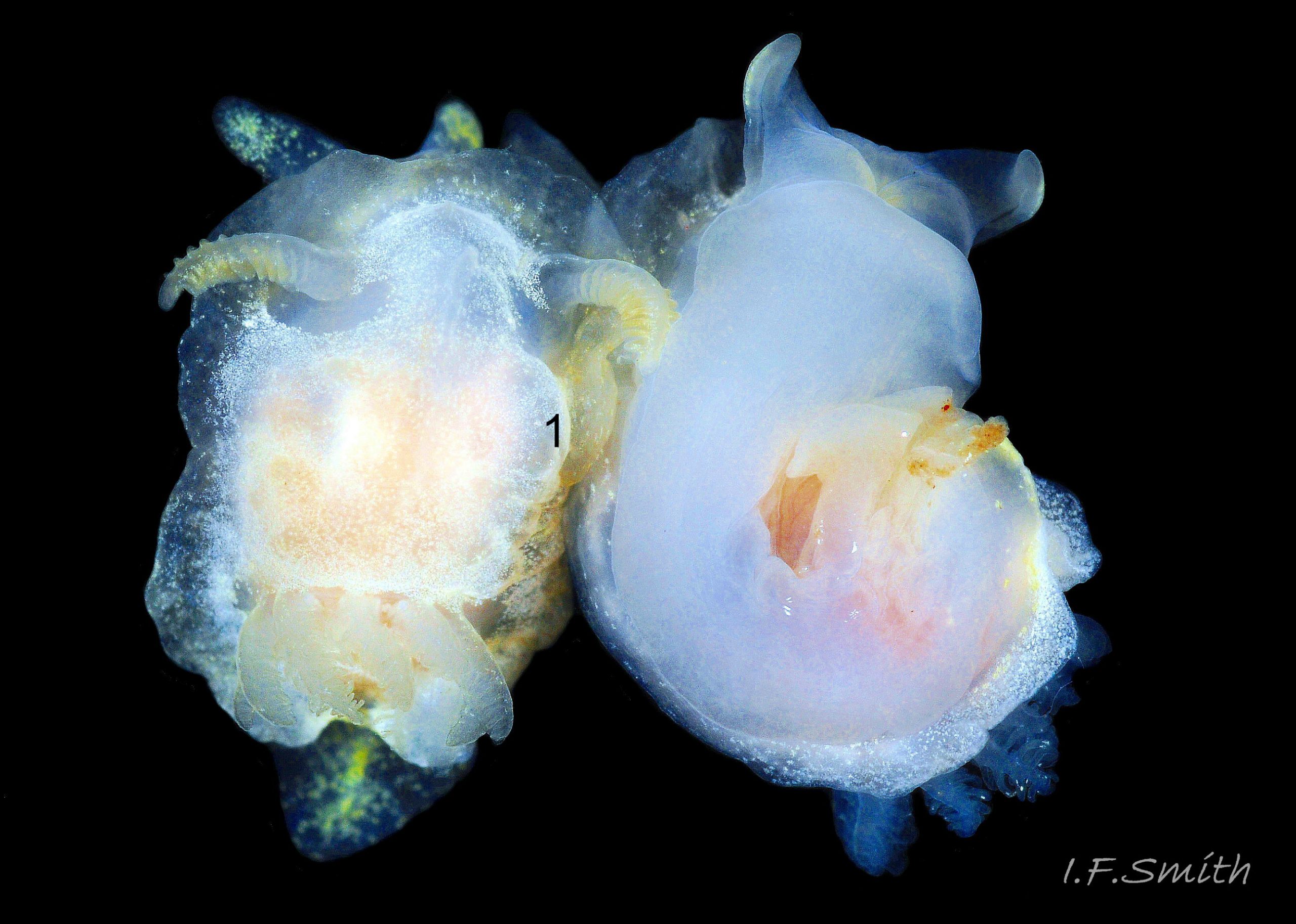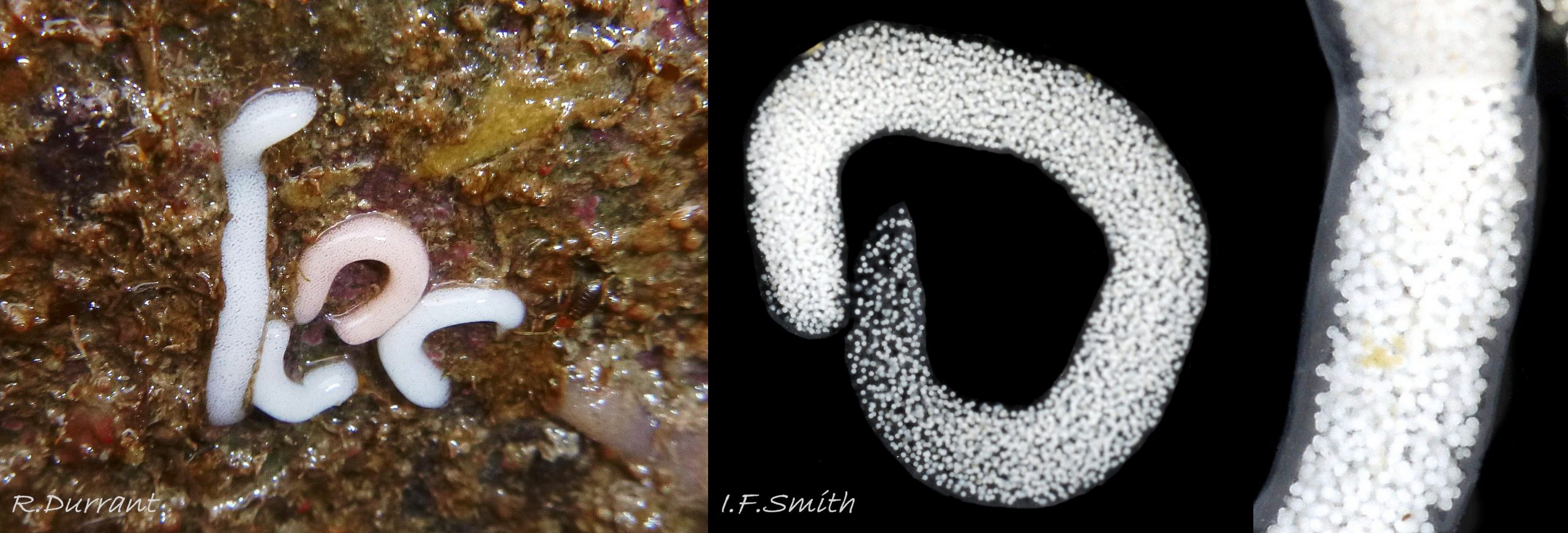Click image to enlarge with full caption. Main text below slider.
Goniodoris nodosa (Montagu, 1808)
PDF available at www.researchgate.net/publication/357061981_Goniodoris_nod…
Current taxonomy: World Register of Marine Species
www.marinespecies.org/aphia.php?p=taxdetails&id=140033
SynonymsDoris nodosa Montagu, 1808; Goniodoris emarginata Forbes, 1840.
GLOSSARY BELOW
Description
The body grows up to 27 mm long (Thompson & brown, 1984). Viewed dorsally, the mantle can just cover the whole body, but the foot and oral tentacles usually protrude 01 Goniodoris nodosa , and parts of the mantle are often reflected to reveal more of the body 02 Goniodoris nodosa & 03 Goniodoris nodosa , especially when viewed from the side 04 Goniodoris nodosa & 05 Goniodoris nodosa. The firm, free rim is often scalloped into points and reflected upwards 05 Goniodoris nodosa . There is a narrow, elevated, undulating medial dorsal ridge 04 Goniodoris nodosa which is translucent and often difficult to discern, except where pigmented with opaque white 01 Goniodoris nodosa. The surface of the mantle is often raised into many mounds, each tipped with a small white mark. On adults they are irregularly arranged over the whole surface, but on juveniles about 2 mm long, tubercles, with the medial ridge, may form three longitudinal ribs 06 Goniodoris nodosa The prominence of the mounds varies with age and breeding condition; sometimes they are absent.
Many of the features described above are often difficult to discern because the outer surface of G. nodosa is almost transparent, and the only colours are the white or yellow-white fine stipple and larger spots of surface pigment. The fine stipple is absent from behind the rhinophores giving the impression of depressions, and a depressed, transparent, stipple-free circle behind the gills gives the illusion of an open pore 02 Goniodoris nodosa . Any yellow pigment is usually most saturated on the oral tentacles and on a medial band on the metapodium 01 Goniodoris nodosa & 05 Goniodoris nodosa. On juveniles about 2 mm long, the fine stipple is often predominantly yellow on the mantle 07 Goniodoris nodosa . The translucent body reveals the colours of pink 01 Goniodoris nodosa or yellow 02 Goniodoris nodosa viscera and, sometimes, a bluish spermatheca within the right side (Alder & Hancock 1845 – 1855) 08 Goniodoris nodosa.
Each rhinophore has a short smooth, translucent basal stem and, when adult, thirteen or fourteen incomplete lamellae on the distal 70%. The lamellae do not extend across the anterior face of the rhinophore 09 Goniodoris nodosa. A short, bluntly rounded apex protrudes beyond the lamellae. The rhinophores are entirely translucent white or yellowish, apart from a few white pigment flecks which are densest distally.
Adults have up to thirteen unipinnate, transparent , colourless gills with thick midribs in a circle around the cylindrical, white anal papilla 05 Goniodoris nodosa & 08 Goniodoris nodosa. Large specimens may have three extra small plumes at the posterior within the main circle 10 Goniodoris nodosa (Alder & Hancock, 1845 – 1855).
The head consists of the ventral yellowish mouth and its surrounds flanked by wide, blunt, flattened, translucent oral tentacles freckled with opaque white or yellow-white distally 03 Goniodoris nodosa. There is only a slight suggestion of an oral veil. In dorsal view, the head is often mostly concealed by the mantle 01 Goniodoris nodosa unless the mantle is reflected 02 Goniodoris nodosa or retracted 04 Goniodoris nodosa.
The sole of the foot 03 Goniodoris nodosa is approximately oblong, with long parallel sides and a broad anterior with rounded corners, but the posterior comes to a rounded point. It is translucent white showing pink viscera centrally. There are no propodial tentacles. Dorsally, the foot is translucent white with small, widely scattered, opaque white spots 04 Goniodoris nodosa , and the metapodium, which protrudes beyond the mantle, has a yellow medial band.
Key identification features
G. nodosa (Montagu, 1808)
1: Body translucent white with opaque white, and sometimes yellow, flecks 01 Goniodoris nodosa . No other colours apart from pinkish or yellowish viscera visible through translucent body. Usually a yellow or white medial band on the metapodium. Juveniles sometimes covered in powdering of yellow 07 Goniodoris nodosa.
2: Mantle is more extensive than on G. castanea but usually leaves part of the body exposed 05 Goniodoris nodosa though it can extend/move position to cover most of the body. Its edge is often flexed into undulations and does not stand upright in a fixed position.
3: No ridge on the oral tentacles.
4: Oral tentacles attached to the head; only a slight oral veil 03 Goniodoris nodosa .
Similar species
G. castanea
1: Body chestnut brown, varying to pinkish white and dark purple with opaque white or, occasionally, yellow flecks 11 Goniodoris nodosa.
2: Mantle with erect fixed edge does not cover sides of body 12 Goniodoris nodosa.
3: Ridge on the oral tentacles 12 Goniodoris nodosa
4: Oral tentacles are lateral extensions of an oral veil 13 Goniodoris nodosa.
Habits and ecology
G. nodosa lives on the lower shore of rocky coasts and sublittorally to 20 m in Britain and 120 m in southern Norway. Juveniles feed on polyzoans, including Alcyonidium polyoum, Callopora dumerili and Flustrellidra hispida. Adults eat ascidians, including Diplosoma listerianum, Botryllus schlosseri and Dendrodoa grossularia 14 Goniodoris nodosa (Thompson & Brown, 1984).
As with other simultaneous hermaphrodite nudibranchs, mating is performed with mutual penetration by a couple meeting head to head with their genital apertures behind their right cephalic tentacles adjacent to each other. Sometimes they mate both facing the same direction with one lying prone and the other supine so that their genital apertures are proximate to each other 15 Goniodoris nodosa . A long, cylindrical, white or rosy spawn mass is attached to the substrate with curvature varying from almost straight to a coil of one and a half turns 16 Goniodoris nodosa . Each mass contains about 14000 to 32000 ova (Thompson & Brown, 1984). The spawn is fertilized as it is deposited with sperm from prior copulation stored in the bursa copulatrix 08 Goniodoris nodosa. The principal spawning season in Britain is from January to May, sometimes with a further period in autumn if conditions have favoured rapid growth and maturity of the spring generation (Thompson & Brown, 1984). Shelled veliger larvae drift as plankton before settling on the sea floor and transforming into adults. Adults die in May after spawning, so the species is inconspicuous in summer until juveniles grow in August 07 Goniodoris nodosa.
Distribution and status
G. nodosa occurs from Norway and Faroes to Galicia, Spain (Trigo et al.) GBIF map www.gbif.org/species/2291985 .
It is common all round Britain and Ireland on hard substrate.
UK distribution map species.nbnatlas.org/species/NBNSYS0000175525 .
Acknowledgements
For use of their images, I gratefully thank Roy Dahl, Rob Durrant, Rokus Groeneveld ( www.diverosa.com/ ) and David Kipling.
References & links
Alder, J. & Hancock, A. 1845-1855. A monograph of the British nudibranchiate mollusca. London, Ray Society. www.biodiversitylibrary.org/item/131598#page/170/mode/1up
Picton, B.E. & Morrow, C.C., 2010. Encyclopedia of Marine Life of Britain and Ireland (for prey organisms) www.habitas.org.uk/marinelife/index.html
Thompson, T.E. & Brown, G.H. 1984. Biology of opisthobranch molluscs 2. London, Ray Society.
Trigo, J.E.; Diaz Agras, G.J.; Garcia Alvarez, O.L.; Guerra, A.; Moreira, J.; Pérez, J.; Rolán, E.; Troncoso, J.S,; Urgorri, V.. 2018. Guia de los Moluscos Marinos de Galicia. Servicio de Publicacións da Universidade de Vigo.
Current taxonomy: World Register of Marine Species
www.marinespecies.org/aphia.php?p=taxdetails&id=140033
Glossary
allosperm = (in hermaphrodites) sperm received from another individual.
bursa copulatrix = (a.k.a. spermatheca) copulatory pouch or sac for receiving allosperm for storage or partial consumption/processing (sources differ on function).
distal = away from centre of body or from point of attachment.
ELWS = extreme low water spring tide (usually near equinoxes).
hermaphrodite, simultaneous = individual has both male and female features able to function at the same time with similar partner.
lamellae = small plates on rhinophores.
LWS = low water spring tide, two periods of a few days each month when tide falls lowest.
mantle = (of nudibranchs) sheet of tissue forming part or all of dorsal body surface.
medial = midline of body or organ.
metapodium = hind part of the foot.
oral tentacles = pair of tentacles on or near edge of mouth.
oral veil = anterior extension of head into a flat sheet, sometimes with lateral extensions to form tentacles.
papilla = (pl. papillae) small, nipplelike, protruberance.
plankton = animals and plants that drift in pelagic zone (main body of water).
propodial = at the front of the foot.
rhinophore = chemo-receptor tentacle; many sea slugs have a pair on top of the head.
spermatheca = (See bursa copulatrix.)
unipinnate = (of gill plume) branching singly; boughs but no subsequent branches or twigs, in one plane like a feather.
veliger = shelled larva of marine gastropod or bivalve mollusc which moves by action of cilia on a velum (bilobed flap). Stage may be passed in plankton or within liquid-filled egg-capsule.
